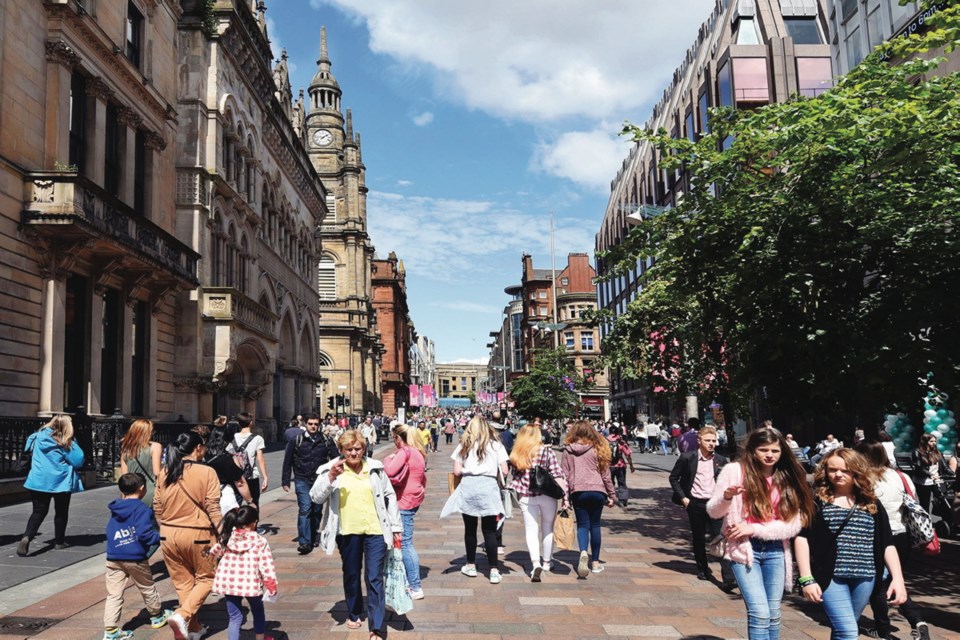Glasgow, astride the River Clyde, is a surprising city ŌĆö and ScotlandŌĆÖs most underrated destination. Just an hour from Edinburgh (making it an easy day trip), Glasgow offers an energetic dining and nightlife scene, fanciful architecture and top-notch museums ŌĆö most of which are free. Today, this once-run-down city feels revitalized, and Glaswegians (sounds like ŌĆ£NorwegiansŌĆØ) are eager to give visitors a warm welcome.
Locals here are some of the chattiest people in Scotland ŌĆö and have the most entertaining (and impenetrable) accent. One once told me he was ŌĆ£British by passport and Scottish by the grace of God.ŌĆØ Their unpretentious friendliness makes connecting with people here a cinch. ThereŌĆÖs no upper-crust history, and no one puts on airs. In Edinburgh, people identify with the quality of the school they attended ŌĆö in Glasgow, itŌĆÖs their soccer team allegiance.
In its 19th-century heyday, Glasgow was one of EuropeŌĆÖs biggest cities and the second-largest in Britain, right behind London. It was at the forefront of the Industrial Revolution, and is said to have produced a quarter of the worldŌĆÖs oceangoing ships. After the Second World War, the city went through tough times, giving it a gritty image. But modern Glasgow is rejuvenating itself with a thriving cultural scene and its trademark knack for design and artsy edge.
Glasgow tells its story throughout its vibrant streets and squares. At the heart of the city is George Square, decorated with a WhoŌĆÖs Who of statues depicting great Scots, from literary figures such as Sir Walter Scott and Robert Burns, to James Watt, who perfected the steam engine that helped power Europe into the Industrial Age. On the same square, in front of the City Chambers, stands a monument to Glaswegians killed in the World Wars.
Architecture buffs flock here to appreciate the unique Glaswegian flair evident across the cityŌĆÖs Victorian facades, early 20th-century touches and bold and glassy new construction. Most beloved are the works by Glasgow-born architect Charles Rennie Mackintosh. During the late 1800s and early 1900s, Mackintosh brought an exuberant Art Nouveau influence to this otherwise practical, working-class city with his stimulating blend of organic shapes and Japanese-inspired design.
YouŌĆÖll have several opportunities to experience MackintoshŌĆÖs work in Glasgow. The Mackintosh at the Willow tearooms, dating back to 1903, are an Art Nouveau masterpiece where you can have a meal or tea, or pay to browse exhibits about the history of the place. During the industrial boom of the late 19th century, Victorian morals prevailed and the Scottish temperance movement was in full force. Tearooms such as the Willow were designed to be an appealing alternative to pubs ŌĆö places where women could visit unescorted, without risking an undesirable reputation.
Across town, the Mackintosh exhibit at the Kelvingrove Art Gallery hosts a collection of the architectŌĆÖs works. Housed in a grand, 100-year-old, Spanish Baroque-style building, the Kelvingrove is GlasgowŌĆÖs best museum ŌĆö like a Scottish Smithsonian, with everything from natural history displays to fine artwork by the great masters.
GlasgowŌĆÖs artsy vibe extends beyond its museums, permeating city streets with eclectic mural art. City officials have cleverly co-opted street artists by sanctioning huge, colourful murals around town to prevent tagging. This creative problem-solving is typical of Glaswegians ŌĆö taking counterculture energy and turning it into something positive. ThereŌĆÖs even a city map available that traces the cityŌĆÖs best mural art.
To feel the pulse of the city, head to busy Buchanan Street, nicknamed the ŌĆ£Golden Z,ŌĆØ for the way it zigzags through town. As home to the top shops in town, itŌĆÖs also dubbed the ŌĆ£Style Mile.ŌĆØ This is the place to people-watch, gaze at the elegant architecture above the storefronts and enjoy the talented buskers that bring the boulevard to life.
Live music is a major part of GlasgowŌĆÖs personality, and one of the best places to experience this is in the cityŌĆÖs West End.
I recently bellied up to the bar at the Ben Nevis pub, where I expected to hear traditional Scottish music. But as the session got going, I was surprised to learn that the entire UK was represented in the band, with musicians from Northern Ireland, Wales, England and Scotland.
My Glaswegian friend pointed out that this is the fun reality of Glasgow, where tribes come together to make music. And that (as a microcosm of our world in general) is a beautiful thing.
The more time you spend in Glasgow, the more youŌĆÖll appreciate its edgy, artsy vibe and quirky, laid-back personality.
The cityŌĆÖs earthy charm and the GlaswegiansŌĆÖ love of life make it one of my favourite stops in Britain.
┬Āwrites European travel guidebooks and hosts travel shows on public television and public radio. Email him at [email protected] and follow his blog on .


